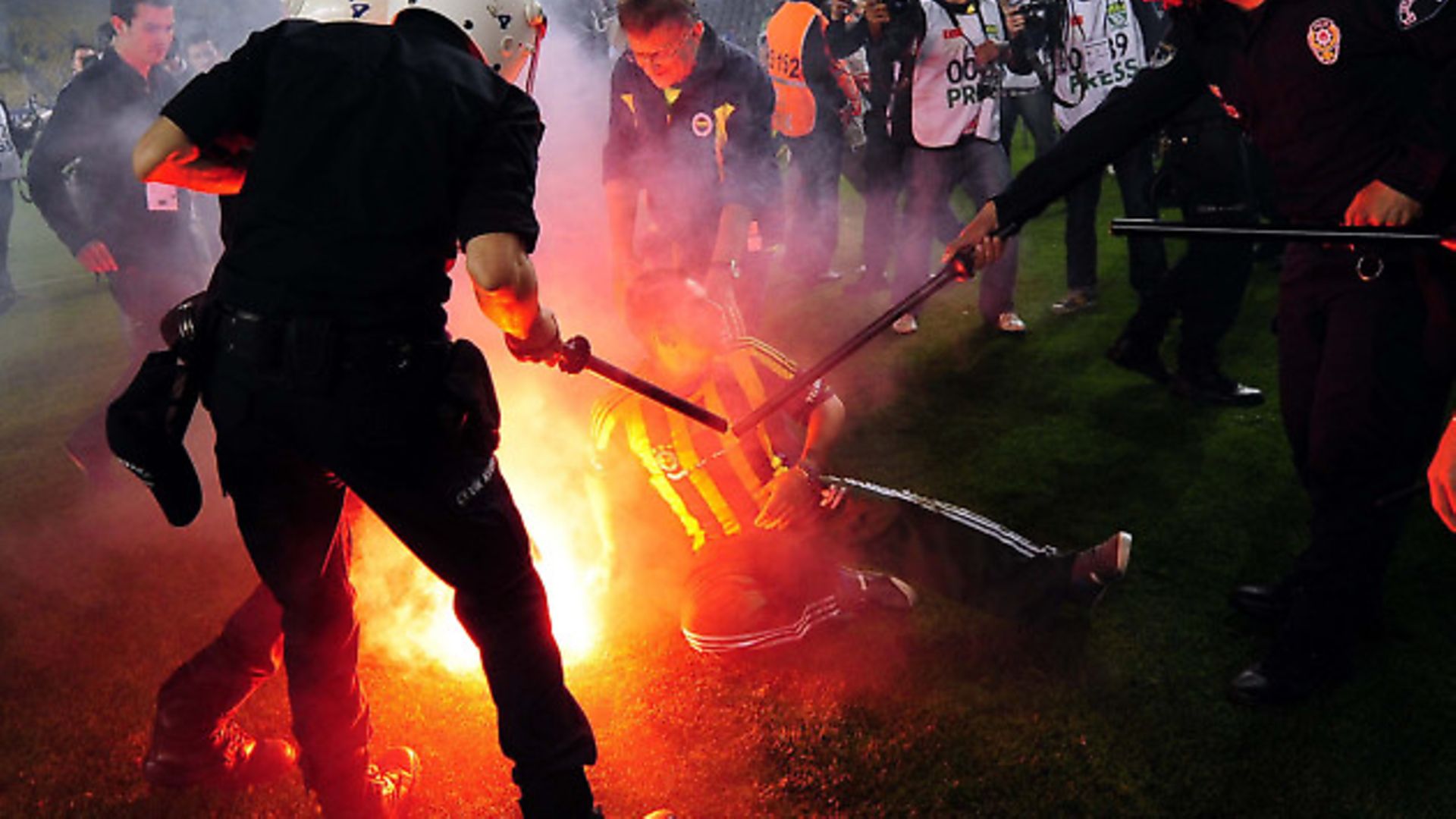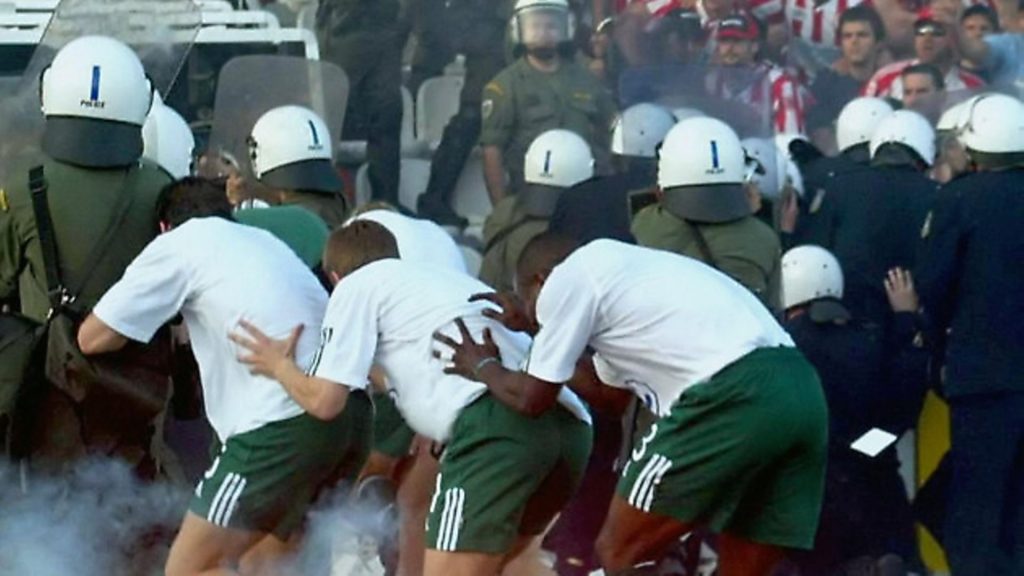
Think the north London, Merseyside or even the notorious Old Firm derbies are the pinnacle of footballing rivalries? Europe’s football hooligan clashes will shock you

The blood and thunder of a local derby is one of the most compelling aspects of any sport. But European football’s rivalries often spill from the field of play to the terraces and beyond. Hatred cultivated over decades encompasses more than just geography but religion and politics and the ugly face of extremism is evident in the stands where the ultras rule.
Olympiacos v Panathinaikos
Known as the Derby of the Eternal Enemies this may be the greatest club enmity in all sports. One of Greece’s oldest clubs, Panathinaikos traditionally represented Athenian high society; Olympiacos’ fans, meanwhile, tended to come from the more rough-and-ready adjoining port of Piraeus.
The dust-ups between the rivals are legendary. One of the more notable ones being the Greek Cup Final in June 1962 when two players were dismissed for fighting inside the first five minutes. A further Olympiacos player was given his marching orders after 30 minutes and, with the match having to be suspended twice and the referee needing to seek shelter from incoming missiles, the first half lasted 66 minutes. That’s an impressive 21 minutes of time added on without a single player receiving a significant injury. Half-time lasted 35 minutes in an effort to calm everyone down. This may have seemed sensible at the time but it meant when the game entered extra time, and with the stadium in utter darkness, the referee had no option but to call the whole thing off. The Greek FA, understandably concerned about the implications of a replay, decided against scheduling a replay. So there there was no winner of the 1962 Greek Cup.
And the rivalry is not confined to football. As is common in Europe, both clubs encompass other sports including basketball and water polo, where the burning hatred runs just as deep. In 2007, a Panathinaikos supporter died during a clash between fans of the two teams before a women’s volleyball match. As a result the Greek government suspended play in all professional team sports for two weeks. Following the violence, police raided 15 supporters’ clubs, seizing dozens of makeshift weapons including pick axes, iron bars and baseball bats.
https://www.youtube.com/watch?v=En6wViD1jtY
Red Star Belgrade v Dinamo Zagreb
The 1990 encounter between these rivals would be the last match played before the Yugoslav League collapsed and the deadliest conflict in Europe since the Second World War commenced. The fact that Arkan, the Serbian paramilitary leader, was among the Red Star Belgrade fans travelling to Croat Dynamo Zagreb was not the best of pre-match signs. Nor, with hindsight, was the further fact that fans had stockpiled rocks and acid.
The Red Star fans threw their seats on the field. The Dinamo fans invaded the pitch. The police laid into the Dinamo fans. And then the players became involved. Most notably Zvonimir Boban, the Dinamo captain nicknamed Zorro. A total of 138 police and fans were injured in the riot. And the Red Star players had to be airlifted to safety by police helicopters.
Speaking afterwards, Boban said: ‘It was the best thing I’ve ever done. I had to defend our people and I wanted to fight the injustices that were being done that day. The frustrations that had built up for so many years just exploded.’
Along with hero status Boban also received a six-month ban from the Yugoslav national team, causing him to miss the 1990 World Cup.
Boban is now an outspoken analyst for Sky Italia, having completed his history degree at the University of Zagreb.
Arkan fared less well, being assassinated in 2000 before his forthcoming trial for crimes against humanity could take place at the UN.
SV Spakenburg v IJsselmeervogels
Something of a collector’s item from the Dutch third division and the only amateur contender in the list. This town derby attracts a crowd of 9,000 – half its entire population. Wearing red are Ijsselmeervogels, a team founded by local fishermen who have won the Dutch amateur championship seven times and in 1975 reached the cup semi-finals. In blue, SV Spakenburg, a team historically consisting of farmers who completed a league and cup double in 1985. So far, so sane. But the 1987 match was somewhat different with one of the IJsselmeervogels fans lobbing a home-made bomb, on to the pitch, injuring a linesman.
The game finished 0-0. The authorities responded by placing the teams into different divisions until they had learned to behave themselves.
Since then, they have resorted to jokes not bombs. There have been giant mascots, pigs running loose, and a plane emblazoned with the message ‘Hup SVS. Schijt aan de buren’ (which roughly translates as ‘Come on Spakenburg. Shit on the neighbours’) and toilet brushes thrown on the pitch.
Levski Sofia v CSKA Sofia
Another Eternal Derby, this one is contested between two teams who have won the Bulgarian League an exceptional 57 times between them. In the days when this was played on the far side of the Iron Curtain, Levski was the team of the Ministry of Internal Affairs and CSKA the team of the Ministry of Defence.
A typical clash was the 1985 Cup Final. This featured a Maradona-style hand of God goal, two dubious penalties, four red cards, much scuffling and culminated with a full-on brawl. Perhaps the most shocking moment of the game was when Levski goalkeeper Bobby Mihailov – who went on to have an unsuccessful stint between the sticks for Reading – struck the referee twice.
The game finished with CSKA winning 2-1 but contained so much violence that the Communist Party decided not to bother with points deductions or enforced relegations and instead ordered both clubs to be disbanded and banned six players for life, including a 19-year-old Hristo Stoichkov. Afterwards, the brutalised referee said: ‘There is a truth about matches like this, which is that no matter how strict the referee is, if the players want to behave badly, a referee cannot stop them.’
The disbandments were later rescinded but Stoichkov, the youngest player on the pitch, was banned for a year.
Lazio v Roma
The Derby of the Big Dome (St. Peter’s). Although Roma is traditionally seen as the left-wing, inner-city working-class team to Lazio’s middle-class, suburban right-wingers, the distinctions are blurred somewhat by Roma being formed at the behest of a Fascist Party official, while Lazio managed to thwart Mussolini’s desire to merge both teams into a Roman superclub.
That said, as recently as the beginning of the millennium, Lazio ultras would unfurl a huge banner which read ‘Team of Blacks, Crowd of Jews’ taunting their counterparts at Roma, and have expressed support for Arkan (see Red Star Belgrade v Dinamo Zagreb).
A typical contest took place in 2004 when a group of Roma ultras caused the cancellation of a derby match four minutes into the second half, after a rumour spread around the stands that a boy had been killed outside by a police car. In fact the police had covered the boy with a white sheet to provide a filter as he was having great difficulty breathing due to being overcome with tear gas.
The more the police denied things over the public address system, the less the fans believed them and a major riot kicked off with more than 170 police injured but just 13 arrests made.
The abiding image from the game is of the Roma captain, Francesco Totti, surrounded by ultra leaders telling him not to play. A striking symbol of the power the ultras exerted over Italian football. As he walked back to the players, Totti called out to the manager: ‘If we play on, they’re going to kill us.’
HSK Zrinjski v FK Velez
Mostar is the principal city in the Herzegovina region and became a symbol of the Bosnian War (particularly its damaged bridge). So it is perhaps hardly surprising that local tensions have arisen in its football derby. Zrinjski was founded in 1905 on the primarily Catholic west bank. Velez followed in 1922, on the largely Bosniak Muslim east bank and was shortly thereafter taken over by the local Communist Party. Their histories were troubled from the start with both clubs regularly being forced into, what might euphemistically be called, ‘hibernations’.
Initially these favoured Zrinjski who enjoyed the first half of the century regularly winning the league, particularly during the Second World War. The emergence of the Communist Party after the Second World War soon put an end to that, however, and Velez enjoyed some moments in the sun, winning a couple of Yugoslav Cups.
Long periods of upheaval and varying fortunes meant it wasn’t until 2000, after a gap of a mere 55 years, that the two faced up to each other once again, Zrinjski being supported by the Ultras Zrinjski – Croat and right wing – and Velez by Red Army Mostar – Bosniak and left-wing. Hardly a happy combination.
Rapid Wien v Austria Wien
The third most-played city derby fixture in Europe behind only Scotland’s Old Firm and Edinburgh derbies and every bit as tasty. A 2011 clash had to be abandoned after Rapid supporters invaded the pitch en masse, triggering a prolonged riot which involved hundreds of police officers and culminated in the worst violence Austrian football had ever witnessed. It all kicked off in the 26th minute when Austria scored a second and the Rapid fans decided enough was enough.
Rapid fans are largely based in the north and are traditionally working class, the club was originally called First Workers Club of Wien. Austria, meanwhile, are the team of the bourgeois, was initially called Wien Amateur Sports Society, and incorporated a minimum intelligence requirement into their founding statutes.
Marseille v Paris Saint-Germain
This rivalry is relatively recent, since the metropolitan side is relatively young in football terms, being founded in 1970 and taking until 1986 to win their first Ligue 1 title. The provincial Olympique de Marseille were well-established giants by then.
The match, known as Le Classique, sees France’s richest club play against its most popular. The violence has escalated. The Parisians have attracted right wing extremists. Marseille have a large fanbase among North African immigrants. There have been deaths and match-fixing and the enmity continues with Marseille still the only French team to have won the Champions League.
Galatasaray v Fenerbahce
Galatasaray was founded by old boys from Turkey’s Eton, the Galatasaray High School, which was formed to provide a French-language education for the elites of the Ottoman Empire. Fenerbahce, meanwhile, was formed by local men from the Asian side of Istanbul and are considered to be the people’s club. Around 70% of Turkish football fans support one or other club.
Together they contest the Intercontinental Derby, which is traditionally a torrid affair as Fenerbahce’s firm Kill For You face up to Galatasaray’s UltrAslan – a brand which has sold more replica shirts than the actual team.
The hatred is so intense that it sometimes even spills over to wheelchair basketball contests, which away fans are allowed to attend.
It all started in 1934 when a friendly led to violence with fans and players getting involved. Since then it has been pretty much non-stop. However, fans of both sides did joined together to protest against Prime Minister Tayyip Erdogan’s government and his plans to redevelop Istanbul’s historic Taksim Square.









